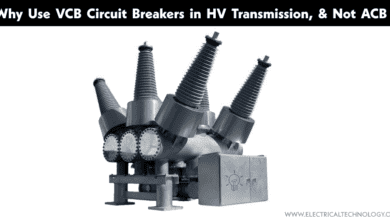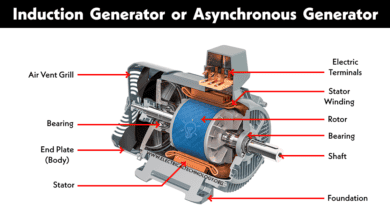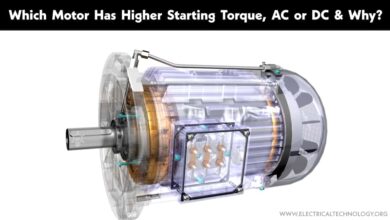What is the Difference Between Salient Pole and Non-Salient Pole Alternator?
What is Alternator?
An alternator (or synchronous generator) is an electrical machine that is used to convert mechanical energy into electrical energy in the form of alternating current or AC. In other words, it is an AC generator or also known as a Synchronous generator.
A synchronous generator output frequency depends only on the speed of the prime mover i.e. its output frequency is synchronized with the RPM of the prime mover. Therefore it is used for generating specific frequency voltage.
An alternator or synchronous generator has mainly two parts: a stator (stationary part), and a rotor (rotating part). The stator of an alternator has armature winding where the current is induced and the output is supplied. Whereas the rotor contains the field winding that is used for generating the necessary magnetic field. The field windings are energized by a separate DC source.
The alternators are classified based on the design of this rotor which also affects the performance of the alternator as well i.e. salient pole and cylindrical (non-salient) Pole rotor alternator.
- Related Post: Difference Between Alternator and Generator
Salient Pole Alternator
The salient pole alternator has a salient pole rotor. The term ‘salient’ means protruding or projecting, as the poles on its rotor are projected outwards as shown in the figure below.
The salient pole rotor has many ‘salient’ poles mounted on a core made of magnetic laminated steel or cast iron of good magnetic properties. The lamination is done to reduce the Eddy current losses whereas the magnetic property is used to have better flux linkage and reduce flux leakage.
The pole in the salient pole rotor also includes multiple slots for damper winding that is used to prevent haunting in alternators.
As the rotor holds field windings in the alternator, the field windings are wound across the extruding poles. The field windings are then connected in series leaving two terminals for DC excitation. A separate DC source is connected through the slip ring and brush configuration to generate the necessary magnetic field and poles.
The main features of the Salient Pole Alternator
- The poles are protruding and extended outward.
- It has a large number of poles about 4 to 60.
- It has a large diameter
- It has a small axial length
- It has lower mechanical strength. Therefore it is used for only low and medium-speed applications in the range of 100 to 1500 RPM.
- Its design flaw is that it has comparatively high windage losses.
- It cannot handle high speed due to high windage loss.
Related Post: Difference Between AC and DC Generator
Cylindrical Pole Alternator
The second type of alternator is the cylindrical pole type whose rotor has non-salient or cylindrical poles. The rotor of such an alternator has poles that are not protruding as shown in the figure below.
The core of the cylindrical pole rotor is also made of a laminated steel core that is slotted for holding the field windings. but the portion that is designed as poles remains unslotted as shown in the figure.
It has very few numbers of poles usually 2 or 4. The diameter of the rotor is small having a longer axial length. The design allows low windage losses that enable high-speed operation.
The main features of cylindrical pole alternator
- It has non-salient poles or its poles are not protruding.
- It has a few number of poles i.e. 2 or 4
- It has a small diameter
- It has a longer axial length.
- Its design allows high mechanical strength making it more durable and have very low windage losses
- It enables it to have the high-speed operation up to 3000 RPM.
- It generates no noise in the system.
- Related Post: Difference Between Servo Motor and Stepper Motor
Comparison Between Salient Pole and Cylindrical Pole Alternator
The following comparison table shows the key differences between salient pole and non-salient pole alternators (synchronous generators).
| Salient Pole Alternator | Cylindrical Pole Alternator |
| The type of alternator whose rotor has poles that are protruding or projecting outward is called the Salient pole alternator. | The type of alternator whose rotor is cylindrical or the poles are not protruding is called a cylindrical or non-salient pole alternator. |
| The rotor poles protruding outward from the rotor core. | The rotor poles are not protruding but rather formed from the unslotted portion of the core. |
| It has a large number of poles than a cylindrical pole alternator. | It has fewer number of poles than the salient pole alternator. |
| It is complicated to design. | It is simple to design. |
| It has a larger diameter. | It has a smaller diameter. |
| It has a smaller axial length. | It has a longer axial length. |
| It requires damper winding to prevent haunting or oscillations. | It does not require damper winding. |
| It has non-uniform flux distribution. Thus its waveform is not as smooth as the cylindrical pole alternator. | It has uniform flux distribution generating a smooth sinusoidal waveform. |
| It has a non-uniform air gap due to the protruding poles on the core. | It has a uniform air gap due to the smooth cylindrical structure of the rotor. |
| It has high windage loss. | It has lower windage loss. |
| It has lower ratings than cylindrical alternators for the same size. | It has higher ratings than salient pole alternators for the same size. |
| It is used for low and medium speeds up to 100 RPM to 1500 RPM. | It is used for high-speed applications up to 3000 RPM. |
| Salient pole alternators are used in hydro turbines. | Cylindrical pole alternators are used in thermal and nuclear plants. |
- Related Post: Difference Between Brushed and Brushless Motor
Main Differences Between Salient Pole and Cylindrical Pole Alternator
Definition
- The salient pole alternator is a type of alternator whose rotor has salient or projecting poles.
- The non-salient or cylindrical pole alternator is a type of alternator whose rotor is cylindrical having non-protruding poles.
Rotor
- The salient rotor has protruding or projecting poles on the surface of the laminated steel core. Excitation windings are wound around the polearm
- The cylindrical pole rotor has a solid steel core with slots for excitation windings. Whereas the unslotted portion forms the poles.
Poles
- The salient pole rotor has a larger number of poles. Usually, the number of poles reaches up to 64.
- The non-salient pole rotor has fewer number of poles between 2 and 4.
Size
- The salient pole alternator has a large diameter with a small axial length.
- The non-salient pole alternator has a smaller diameter with a long axial length.
Damper windings
- The salient pole alternator requires separate damper winding to prevent haunting.
- The cylindrical pole alternator does not require damper winding.
Haunting is a phenomenon that occurs due to variations in load. When the load is changed, the rotor rotates back a few degrees to find another synchronous point causing oscillation.
Windage loss
- The salient pole rotor has high windage loss due to the large air gap in it. The loss increase with speed. Therefore, salient pole alternators are not suitable for high speed.
- The cylindrical pole rotor has a small air gap and has a cylindrical periphery. Therefore it has low windage loss.
Speed
- The salient pole alternator is used for low to medium-speed applications where the prime mover has 100 RPM to 1500 RPM speed.
- The cylindrical pole alternator allows it to have high speed where the prime mover can attain up to 3000 RPM.
Related Posts:
- Difference between Synchronous and Asynchronous Motor
- Difference Between Salient Pole and Cylindrical Pole Alternator
- Difference Between Squirrel Cage and Slip Ring (Wound) Rotor
- Difference Between Single Phase & Three Phase Induction Motor
- Difference Between AC and DC Motors
- Difference Between AC and DC Generator
- Difference Between a Transformer and an Induction Motor
- Difference Between Alternator and Generator
- Difference between AC Drives and DC Drives
- DC Machine – Construction, Working, Types and Applications
- Induction Generator or Asynchronous Generator: Construction & Working
- Alternator or Synchronous Generator: Construction, Working, Types and Applications
- Synchronous Motor: Construction, Working, Types & Applications
- Three Phase Motor Power & Control Wiring Diagrams
- Electric Motors Symbols
- Types of Electric Motors
- Applications of Electric Motors




 Difference Between Squirrel Cage and Slip Ring (Wound) Rotor
Difference Between Squirrel Cage and Slip Ring (Wound) Rotor Why Use VCB Circuit Breakers in HV Transmission, & Not ACB?
Why Use VCB Circuit Breakers in HV Transmission, & Not ACB? Induction Generator or Asynchronous Generator: Construction & Working
Induction Generator or Asynchronous Generator: Construction & Working Difference Between Electronic vs. Electronics Engineering
Difference Between Electronic vs. Electronics Engineering What is Electrical Technology verses Electrical Engineering?
What is Electrical Technology verses Electrical Engineering? Why Do DC Motors Have Higher Starting Torque than AC Motors?
Why Do DC Motors Have Higher Starting Torque than AC Motors?